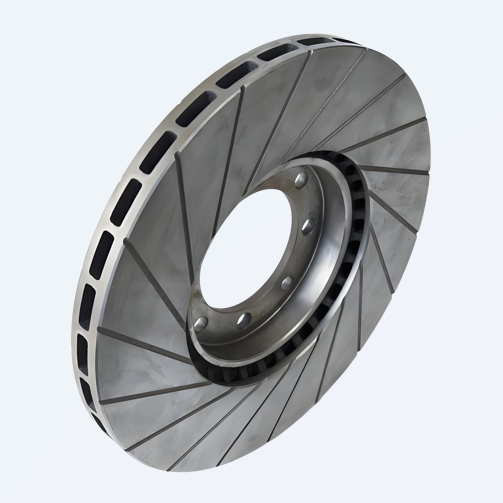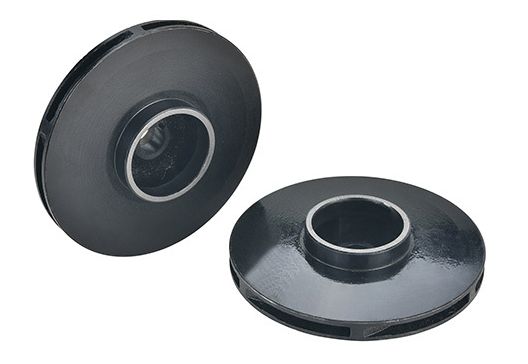Cast iron impellers are critical components in centrifugal pumps, widely utilized across various industries due to their durability, cost-effectiveness, and excellent casting properties. This guide provides a detailed examination of cast iron impellers, focusing on their features, types, applications, and technical specifications, ensuring a clear understanding for engineers, manufacturers, and industry professionals.
Features of Cast Iron Impellers
Cast iron impellers are valued for their robust mechanical properties, making them suitable for demanding industrial applications. The following features highlight their performance and reliability:
- High Strength and Durability: Cast iron, typically containing 2-4% carbon and 1-3% silicon, offers excellent compressive strength, enabling impellers to withstand high fluid pressures and mechanical stresses.
- Abnutzungswiderstand: Gray and white cast iron varieties provide superior resistance to abrasion, ideal for handling abrasive fluids or slurries.
- Kosten-Wirksamkeit: Compared to materials like stainless steel or bronze, cast iron impellers are more economical, reducing production costs without compromising performance in general applications.
- Excellent Castability: The high fluidity of molten cast iron allows for the creation of complex shapes and intricate vane designs with high dimensional accuracy.
- Wärmeleitfähigkeit: Cast iron impellers efficiently dissipate heat, making them suitable for applications involving high-temperature fluids.
- Corrosion Resistance (Limited): While less resistant to corrosion than rostfreier Stahl, cast iron impellers can be treated with coatings like cataphoresis to enhance durability in mildly corrosive environments.
These properties make cast iron impellers a preferred choice for applications requiring robustness and economic efficiency, though material selection must consider fluid characteristics and environmental conditions.

Types of Cast Iron Impellers
Cast iron impellers are categorized based on their design and the type of cast iron used. The primary types include open, semi-open, closed, and vortex impellers, each tailored to specific fluid dynamics and applications. Below is a detailed breakdown of these types:
| Impeller Type | Beschreibung | Material Variants | Key Characteristics |
|---|---|---|---|
| Open Impeller | Vanes attached to a central hub without shrouds, allowing easy passage of solids. | Gray cast iron, ductile cast iron | High tolerance for solids, easy to clean, suitable for low-viscosity fluids with particulates. |
| Semi-Open Impeller | Vanes with one shroud, balancing efficiency and solids-handling capability. | Gray cast iron, ductile cast iron | Moderate efficiency, handles fluids with small solids, easier maintenance than closed impellers. |
| Closed Impeller | Vanes enclosed between two shrouds, optimizing fluid flow and pressure. | Gray cast iron, ductile cast iron | High efficiency, ideal for clean, low-viscosity fluids like water, prone to clogging with solids. |
| Vortex Impeller | Recessed design creating a vortex to handle fluids with gas or solids. | Ductile cast iron | Handles high gas content or solids, lower efficiency, used in wastewater applications. |
Material Variants: Gray cast iron (e.g., HT200, HT250) is commonly used for its machinability and damping properties, while ductile cast iron (e.g., QT400-18, QT500-7) offers enhanced toughness and flexibility due to its nodular graphite structure. White cast iron, with its cementite structure, is less common due to brittleness but is used for high-wear applications.

Applications of Cast Iron Impellers
Cast iron impellers are integral to numerous industries, leveraging their durability and cost-effectiveness. Their applications span from water management to heavy industrial processes. Below are key applications with specific examples:
- Water Supply and Treatment: Used in centrifugal pumps for municipal water supply, irrigation, and wastewater treatment. Closed impellers made of gray cast iron are ideal for clean water, while open or vortex impellers handle wastewater with solids.
- HVAC Systems: Employed in circulation pumps for heating, ventilation, and air conditioning systems, where cast iron’s thermal conductivity ensures efficient heat transfer.
- Industrial Fluid Transfer: Common in chemical processing, oil refineries, and mining, where ductile cast iron impellers manage abrasive slurries or mildly corrosive fluids.
- Agricultural Equipment: Used in irrigation pumps, where open impellers handle water with small particulates, ensuring reliable performance in harsh environments.
- Automotive and Machinery: Ductile cast iron impellers are used in automotive cooling systems and industrial machinery pumps, leveraging their high strength and fatigue resistance.
| Application | Impeller Type | Typical Material | Fluid Type | Specifications |
|---|---|---|---|---|
| Water Supply | Closed | Gray cast iron (HT250) | Clean water | Flow rate: 10-1000 m³/h, Head: 10-100 m |
| Wastewater Treatment | Vortex/Open | Ductile cast iron (QT500-7) | Water with solids | Solid passage: up to 50 mm, Efficiency: 60-70% |
| Industrial Pumps | Semi-Open | Ductile cast iron (QT400-18) | Slurries | Pressure: up to 10 bar, Temp: up to 120°C |
| HVAC Systems | Closed | Gray cast iron (HT200) | Water/Glycol | Flow rate: 5-500 m³/h, Temp: -10°C to 110°C |
Technical Specifications and Considerations
Selecting the appropriate cast iron impeller requires careful consideration of technical specifications and operational conditions. Key parameters include:
- Material Composition: Gray cast iron (2.5-4% carbon, 1-3% silicon) for general use; ductile cast iron for higher toughness. Alloying elements like nickel or chromium can enhance corrosion resistance.
- Operating Conditions: Maximum fluid temperature (typically up to 120°C for cast iron), pressure (up to 10 bar), and pH levels (suitable for pH 6-9 without coatings).
- Flow and Head: Impellers are designed for specific flow rates (e.g., 10-1000 m³/h) and head (e.g., 10-100 m), depending on pump design and application.
- Cavitation Resistance: High-quality casting and precise vane design minimize cavitation, which can cause vibration and wear.
- Manufacturing Precision: Investment casting or sand casting ensures tight tolerances (±0.003 inches per inch), critical for balanced rotation and efficiency.
For corrosive environments, such as seawater, alternative materials like stainless steel or bronze may be preferred, or coatings can be applied to cast iron impellers to extend service life. Regular maintenance, including wear ring replacement, ensures sustained pump efficiency.
Schlussfolgerung
Cast iron impellers are indispensable in centrifugal pumps, offering a balance of strength, durability, and cost-effectiveness. Their versatility across types—open, semi-open, closed, and vortex—enables tailored solutions for water supply, industrial fluid transfer, HVAC systems, and more. By understanding their features, types, and applications, engineers can select the optimal impeller for specific operational needs, ensuring efficient and reliable performance. For further details on material selection or custom impeller casting, consult reputable foundries or manufacturers specializing in cast iron components.
